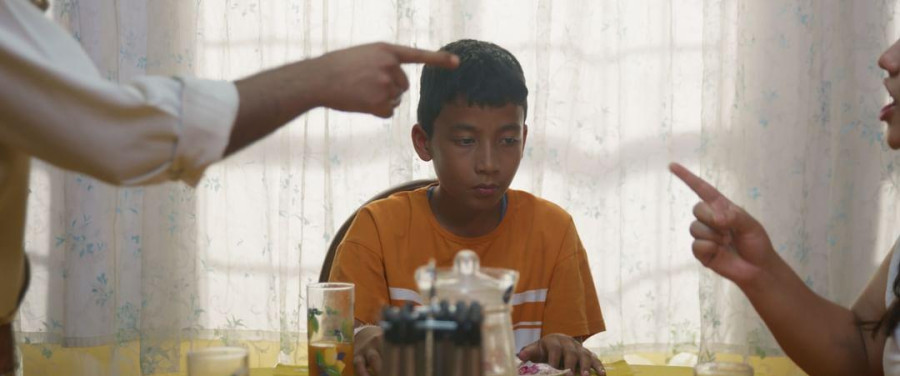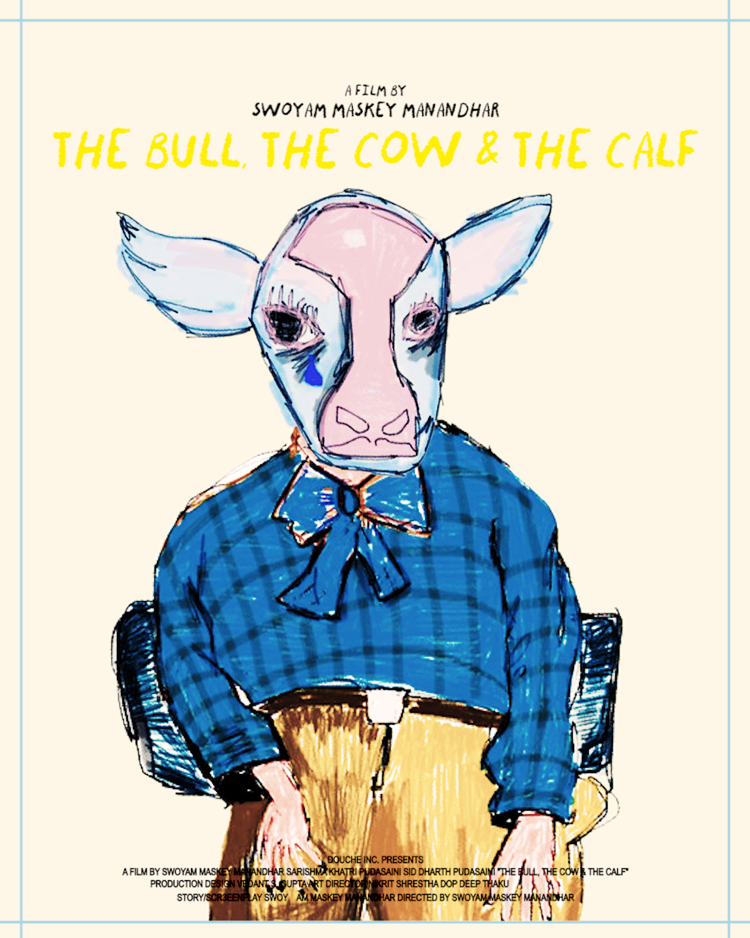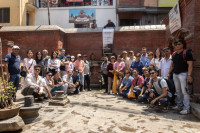Culture & Lifestyle
Tales of a broken family
Swoyam Maskey Manandhar’s directorial debut ‘The Bull, the Cow and the Calf’ is anchored around two families of high and low classes.
Deepali Shrestha
It is always a delight to witness fresh perspectives in films by young filmmakers who are only testing the waters and figuring things out. Embarking on a filmmaking journey with little experience and an awfully tight budget is no easy feat. However, these limitations offer advantages, too. Neither expectations nor administrative hurdlers confine your creativity, and you can explore, experiment and most importantly, make mistakes and learn from them.
If we watch what the now-renowned filmmakers came up with when they started their filmmaking journey (I am thinking of works like ‘Two Cars, One Night’ by Taika Waititi and ‘Bottle Rocket’ by Wes Anderson), their works reflect honesty, passion and sheer determination even if they lack finesse. More often than not, the message and conflict in the do-it-yourself films are no less powerful than professional films. Such films feel fresh, as these independent filmmakers pay attention to issues without the grandeur or larger-than-life element prevalent in commercial films.
‘The Bull, the Cow and the Calf’ is one such film that caught my attention at the 13th edition of the Nepal European Union Film Festival (NEUFF) 2024. Swoyam Maskey Manandhar’s directorial debut, the 13-minute film received a special mention at the NEUFF short film competition. The 13th edition of NEUFF, organised at the CDC Mall in Kathmandu under the theme ‘Fifty Years of EU-Nepal Relations: Celebrating Cultural Diversity’, ran from March 20, 2023, to April 20, 2023. Nine European films and 11 Nepali short films were screened during the festival, which then went to Sudurpaschim Province, Lumbini Province and Karnali Province last month.
The narrative of ‘The Bull, the Cow and the Calf’ is anchored around two families of high and low classes. As the film begins, we are taken to a modest house, where the mother (Sarisma Khatri Pudasaini), the father (Siddhartha Pudasaini) and the son (Sworup Raj Ghimire) are getting ready for the day ahead. Through this opening scene, the filmmakers haven’t wasted much time in allowing us to understand the idea behind the film’s title. The father, representing the bull, scolds the calf, the son, for tearing his jersey’s shorts and the mother, the cow, tries to sew it.
Through the mother, Sarita, who works as a housemaid in an upper-middle-class family, we meet another bull, cow and calf trio. The new family features a mother, Sheela (Santoshi Paudel), who is often consumed with her professional commitments and a father, Amrit (Alexandar Sunny Jaiswal), who is resentful of his workaholic wife and how she has no time for their son, Aman (Prasanna Khatri).
When Sheela says that she has to visit Rupandehi for training sessions and urges her husband to invest more time in their son, he becomes infuriated, and a heated discussion about who should spend more time with the child follows. Both husband and wife exude the sophistication of a modern couple in Kathmandu as they exchange arguments blending English and Nepali and use acronyms of slang like “BS”, reflecting their urbanite demeanour.
This scene is particularly interesting, as it offers a poignant reflection of the disarray regarding parenting in contemporary urban households where both the husband and wife possess a myopic focus towards their individual professional growth, resulting in a breeding ground for familial misunderstanding and neglect. Even though their discussion revolves around the son’s well-being, his presence gets camouflaged as the parents become blinded by their self-centric arguments. In reality, the child is still there, in the thick of the dispute, becoming a passive observer of the escalating tension in the house.
As the film follows the housemaid, it appears as if she is the protagonist, but her role is only confined to guiding the narrative from one scene to the other. The housemaid could be the main character since the frame follows her, but the film isn’t only about her point of view. This lack of distinction between the main character and the protagonist gives unconventionality to the storytelling which could be a challenging approach, especially for short films, as the story needs to be clear in a limited amount of time.
Still, even with this unconventionality, the scenes are thought-provoking and memorable. Manandhar’s debut screenplay is praiseworthy as most of the scenes have a purpose in the overall story, and the dialogues aren’t irrelevant, which is a difficult thing to pull off at the first attempt.
Although the character of the father from the well-off family feels a bit out of tune with the rest of the characters, most of the actors have done a decent job, even with limited or no acting experience. The issues they talk about and the life they portray feel within our reach as they remind us of people we know in our daily lives.
The film’s title seems to have been borrowed from the Nepali saying “Saandhe ko judhai, bachchha ko michai”, which roughly translates to “when bulls fight, the calf gets trampled”. The illustration of how the misunderstanding between parents leads to familial disputes where the children get caught in the crossfire and become the victims is at the heart of ‘The Bull, the Cow and the Calf’.
The portrayal of this triangular conflict between the father, mother and their child is the element that stands out in the film. Manandhar has skillfully depicted this with a clever parallelism between two families of different social statuses where although the parents have rows about different matters, the children become victims in the same manner, depicting the universality of this issue.
Furthermore, the film highlights the intricacies of two different women belonging to different classes and their dynamics with their husbands as they navigate their lives amidst financial hardships or career aspirations. Sheela, the mother from an upper-middle-class family, has the double burden of committing to her job and looking after her son.
Whereas Sarita is trying whatever she can to provide for her family, her attempts are constantly met with her husband’s disgruntlement. In both cases, the men exude varying degrees of ego and are resentful of how their wives are going about their lives. This is perfectly depicted when Sarita’s husband sees her bring the old shirt of Sheela’s husband and the t-shirt of their son, Aman and he admonishes her, saying, “You were their slave, now you have also started begging!”
There are some instances where the film falters. Since the film's primary is to portray the impact of parental conflict on children, it would have been more effective had the makers focused more on the child’s perspective. Although the makers have tried to show another level of the haves and have-nots through the scene with the beggar, it does not add much to the story’s crux. Moreover, by touching on different themes in a short time, the film could risk obscuring its core message.
As the credits roll in, the film lets us reflect on the familial dynamics we were surrounded by when we grew up. Overall, the film offers awareness of children’s vulnerability during any household discord through a gripping portrayal of their silent ordeal. With simplistic cinematography and minimal embellishments, the makers have highlighted a critical issue through ‘The Bull, the Cow and the Calf’.
The film epitomises how budget, experience or crew limitations don’t impede the creation of an impactful story as long as it is handled with sincerity and passion. This film could serve as an inspiration to all the aspiring filmmakers out there who desire to create something but do not have enough resources or expertise.
The Bull, the Cow and the Calf

Director: Swoyam Maskey Manandhar
Duration: 13 minutes
Language: Nepali




 6.84°C Kathmandu
6.84°C Kathmandu.jpg)















